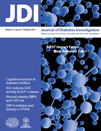Increased plasma levels of retinol-binding protein 4 with visceral obesity is associated with cardiovascular risk factors
Abstract
Aims/Introduction: Visceral obesity has been suggested to be an independent risk factor for cardiovascular disease (CVD); the role of adipokines in the risk for CVD is less clear. Aim of this study was to investigate the relationship between parameters of visceral obesity and index of CVD risk factors.
Materials and Methods: A cross-sectional analysis of healthy males (n = 116) and females (n = 175) for evaluation of clinical, laboratory and anthropometric parameters were undertaken. Abdominal subcutaneous (SAT) and visceral adipose tissues (VAT) were measured by computed tomography. Adipokines, including retinol-binding protein 4 (RBP4) and adiponectin, were determined. The risk for CVD was estimated using the 10-year Framingham Coronary Heart Disease Risk Point scale (Framingham score).
Results: The Framingham score was increased in subjects with metabolic syndrome, and significantly increased with various indices of obesity, traditional risk factors of CVD, C-reactive protein (CRP) and RBP4, but decreased with adiponectin. With multiple linear regression analysis, the Framingham score independently associated with age, smoking status, body mass index, triglyceride and RBP4. The magnitude of the Framingham score showed a linear trend of increase with CRP, VAT and RBP4 (all P < 0.001), but of decrease with SAT and adiponectin (all P < 0.05) at stratified levels of obesity.
Conclusions: RBP4 is increased with visceral fat accumulation and associated with CVD risk factors independent of obesity or traditional risk factors. (J Diabetes Invest, doi: 10.1111/j.2040-1124.2012.00213.x, 2012)




